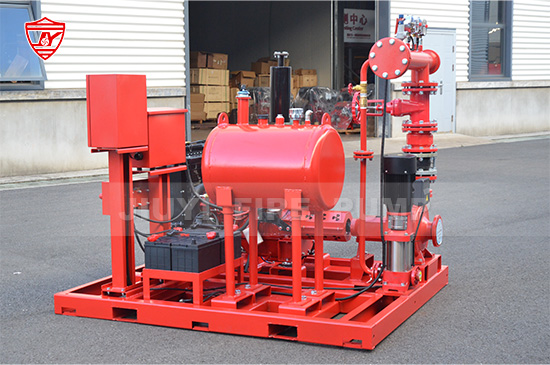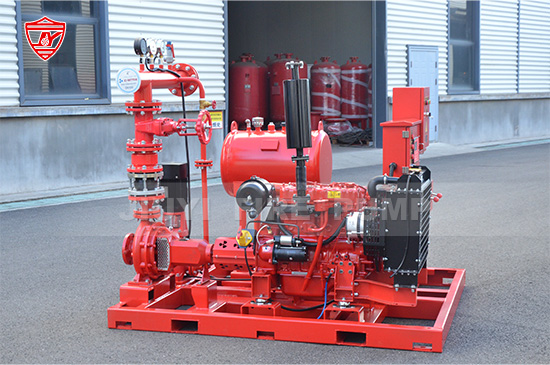Fire pumps are the backbone of reliable fire protection systems, designed to provide consistent water pressure when emergencies strike. However, in hot and humid environments, fire pump systems face additional challenges—corrosion, electrical issues, seal deterioration, and efficiency loss due to heat stress. Whether your pump room is in a tropical region, coastal area, or an industrial site exposed to high temperatures, regular and climate-specific maintenance is essential.
This article outlines key strategies and best practices for maintaining fire pumps in demanding climates, ensuring performance, longevity, and compliance with international fire safety standards.

a. Corrosion and Rust Formation
Humidity accelerates metal oxidation, leading to rust on pump casings, impellers, and fittings. Corrosion weakens components, affects performance, and shortens service life.
b. Electrical Component Degradation
In electric-driven fire pumps, high moisture levels can cause insulation breakdown, short circuits, and motor inefficiency. Even small traces of condensation can lead to major faults.
c. Diesel Engine Overheating
For diesel engine fire pumps, high ambient temperatures place additional stress on cooling systems and lubricants, potentially leading to engine failure during operation.
d. Reduced Lubrication Efficiency
In high temperatures, oil and grease can degrade more quickly. This results in higher friction and wear on moving components, impacting mechanical seal integrity.
e. Condensation and Moisture Accumulation
When humid air enters the pump room, moisture condenses on metal surfaces during cooler night temperatures. Over time, this condensation causes rust and electrical malfunctions.
To ensure your fire pump continues to meet NFPA 25 and other regulatory requirements, follow these targeted maintenance measures for hot and humid regions.
Apply anti-corrosion coatings: Use epoxy or polyurethane-based coatings on metallic surfaces, especially in coastal or marine environments.
Use stainless steel or brass fittings: These materials are more resistant to corrosion than carbon steel.
Install dehumidifiers or ventilation systems: Keep ambient humidity below 60% in the pump room.
Inspect and repaint surfaces annually: Prevent small rust spots from spreading to critical components.
Seal electrical panels: Ensure junction boxes and control panels are tightly sealed to prevent moisture ingress.
Install desiccant packs or anti-condensation heaters: Maintain dry air inside electrical enclosures.
Perform regular insulation resistance tests: Detect early signs of electrical deterioration.
Clean contacts and terminals frequently: Remove oxidation and moisture build-up that can cause short circuits.
Inspect radiators and cooling lines: Make sure they are free from blockages and leaks.
Use manufacturer-recommended coolants: Select formulations suitable for high-temperature environments.
Check fan belts regularly: Heat can cause belts to stretch or crack.
Maintain proper ventilation: Ensure the pump room has sufficient airflow to dissipate engine heat during operation.
Use high-temperature-grade lubricants: Prevent breakdown at elevated temperatures.
Inspect seals and gaskets: Replace if hardened or cracked due to heat exposure.
Grease bearings as per schedule: Maintain proper lubrication to reduce mechanical wear.
Install ventilation fans or air conditioners: Stabilize temperature and reduce humidity levels.
Use moisture sensors: Monitor humidity and trigger dehumidifiers automatically when necessary.
Keep suction and discharge piping dry: Avoid standing water that could lead to microbial growth or corrosion.
A strong preventive maintenance program should include inspections that identify environmental impacts early.
Check for visible rust or corrosion on pump casing, baseplate, and pipes.
Confirm room temperature and humidity are within acceptable limits.
Inspect for oil leaks or coolant drips on diesel pumps.
Run the pump for a short test to ensure smooth operation and pressure stability.
Measure insulation resistance of motors and control panels.
Check alignment between the driver and pump.
Inspect strainers, filters, and valves for sediment or corrosion.
Test diesel engine cooling and fuel systems.
Clean and reapply corrosion inhibitors on exposed metal surfaces.
Perform a full performance test under rated conditions (flow, pressure, and power draw).
Replace lubricants and filters.
Inspect and pressure-test suction and discharge piping.
Recalibrate instruments such as pressure gauges, flow meters, and alarms.
Repaint and reseal pump baseplate and casings.
Maintaining a fire pump in tropical or coastal areas requires diligence. Avoid these common mistakes to prevent system failure when it matters most:
Neglecting humidity control: Even the best mechanical maintenance can fail if the environment stays damp.
Using standard lubricants: Always choose high-temperature-rated oils suitable for your region.
Ignoring pump room design: Inadequate ventilation and poor drainage increase corrosion risks.
Skipping weekly tests: Regular operation prevents stagnant water and ensures seals remain lubricated.
Failing to monitor electrical insulation: Humidity damage often starts unseen inside cables or windings.
In many cases, long-term reliability starts with proper installation and environment design. Here’s how to build resilience into your fire pump system:
Use climate-controlled enclosures: For electric fire pumps, enclosures with air conditioning can extend lifespan.
Elevate pump bases: Avoid water pooling or floor condensation.
Install anti-vibration mounts: Reduce mechanical stress in high-heat environments.
Add thermal insulation: Protect pipes and equipment from external heat sources.
Include drainage systems: Quickly remove condensation or flood water after heavy rain.
When manufacturing or upgrading fire pumps for tropical markets, materials play a crucial role.
Cast iron with epoxy coating: Economical and durable when properly coated.
Bronze impellers: Offer superior corrosion resistance for humid or saline conditions.
Stainless steel shafts and fasteners: Minimize corrosion and galling.
UV-resistant paint: Protects outdoor pump systems from sun exposure.
Material selection should always align with local climate conditions and expected maintenance intervals.
Following NFPA 25: Standard for the Inspection, Testing, and Maintenance of Water-Based Fire Protection Systems is essential for ensuring safety and compliance. Documentation helps track component performance and identify environmental degradation over time.
Keep records of:
Inspection dates and observations
Repairs, part replacements, and lubrication logs
Ambient temperature and humidity readings
Electrical testing and coolant system checks
This documentation not only satisfies compliance requirements but also supports predictive maintenance planning.

Operating in a hot or humid environment doesn’t mean your fire pump must suffer reduced performance or reliability. By implementing targeted maintenance, using proper materials, and ensuring environmental control, you can significantly extend your fire pump’s lifespan.
A proactive approach—combining regular inspections, climate-specific maintenance, and proper documentation—will guarantee that your fire protection system performs flawlessly, even in the most challenging conditions.
Ultimately, maintaining your fire pump is not just about preserving equipment—it’s about protecting lives, property, and operational continuity in the event of a fire emergency.